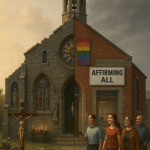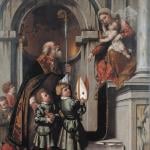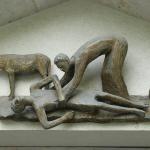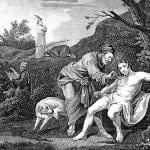USE YOUR ALLUSION: Catholicism, as well as being a very sensual religion, is a very allusive religion. All kinds of seemingly disparate stories or figures or images “rhyme” and are used to refer to one another and illuminate one another’s meanings. Thus baptismal fonts are often carved with scenes like Noah’s ark or the crossing of the Red Sea. The Old Testament scenes generally illustrate some truth about God’s work in the world, as well as showing the continuity between the Old and New Testaments.
I was thinking about this recently in the context of images of the Virgin Mary. Mary is “mapped onto” the Old Testament in several different ways, of which the most intelligible to me are Mary as second Eve, Mary as Israel, and Mary as the Ark of the Covenant. All of these images have different connotations and resonances; they also fit into theological claims. Mary as second Eve is kind of obvious. Mary said yes to God; Eve said no. Mary is contrasted with Eve in somewhat the same way that Christ is contrasted with Adam in I Cor. 15. The Immaculate Conception fits in here; it makes Mary’s “yes” as free, as unbound by the tendency to sin, as Eve’s “no” was. It makes the mirror-image more perfect. I don’t know that that’s an “argument for the Immaculate Conception”; it’s more of an explanation of one reason the Immaculate Conception makes sense.
Mary as Israel is perhaps even more obvious. Just as the Messiah is a son of Israel, so is He a son of Mary. But so far, I haven’t run into much discussion of Mary as the Ark of the Covenant. (Not that I’ve especially been looking.) The image is used in the Litany of Loreto, and it’s a beautiful, strikingly appropriate one: Mary’s womb contained the Word made flesh, just as the Ark contained God’s word–the tablets of the Law. Mary’s womb contained the Man who would fulfill God’s covenant. If anyone knows of (reader-friendly, not Heideggeresque) reflections on Mary as the Ark, please do let me know.











